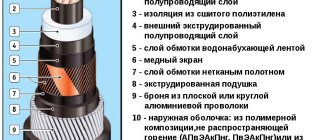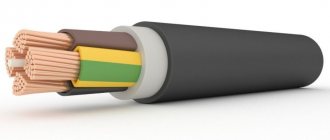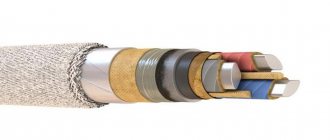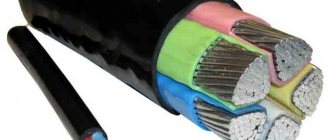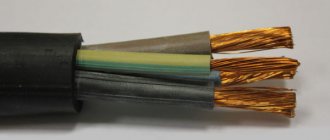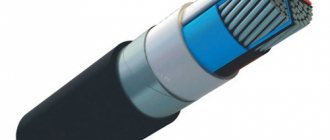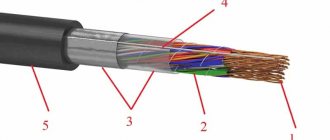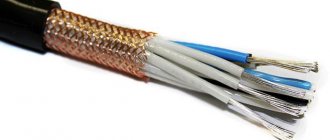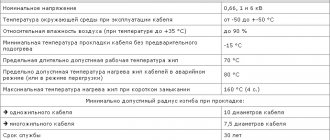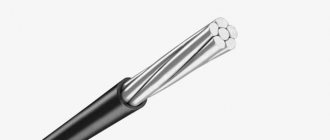Home » Electrical wiring » Wires and cables » KSPV cable
KSPV cable is a signal conductor that is used to deliver an electrical signal to consumers. As a rule, it is used to connect alarm systems and use them in communication and communication systems. In this article we will make a detailed review of the conductor, recall its main technical characteristics and talk about its scope.
What is KSPV cable
The KSPV cable is a signal wire that is used to carry out fixed internal installation during connection of the alarm system, communication and network communication. It has a marking that indicates: cable, intended purpose - signal transmission system, polyvinyl chloride sheath. May have an additional abbreviation, four cores and a millimeter conductor diameter.
KSPV cable
Note! Indispensable during the installation of fire and security alarms and information processing systems. This is a budget option for organizing a network connection. Used indoors and outdoors, but not laid where the wire is not protected from direct sunlight.
There are aluminum and copper core cables, single-wire and multi-wire conductors, wires with a polyethylene inner sheath, KSPV with shielding and an anti-feather component in the insulating layer, which prevents the combustion process.
Decoding
The multi-wire modification comes with an additional letter G (KSPVG). This symbol means conductive flexibility and increased deformation resistance. This option can be placed on a route where the bend radius is smaller according to the standards.
Application of screen in wire
Kspv 4x0 5 cables and other varieties of products of this type are used to transmit control, control, and information signals. If there is a high level of electromagnetic interference, the data will be distorted. Such situations provoke false alarms of alarm systems and disrupt the functionality of automatic devices. Similar conditions are typical for production shops where powerful drives and electromagnets operate. Similar problems arise near power lines.
To eliminate the noted problems, shielding is used. An additional continuous layer of aluminum foil, another conductive material, is installed under the outer shell.
As a rule, a special thread (marked with an arrow) is added to the design to simplify cable cutting during installation operations.
This engineering solution, in addition to improved noise immunity, increases the strength of the product. For a detailed study of the requirements of current standards, you can consider the relevant sections of GOST R 53769-2010.
The considered modernization increases the weight and size of the product. For comparison with typical indicators, below are data for cables with shielding (an additional symbol in the designation is “E”).
Weight and dimensions of KSPEV
| Serial models (number/diameter of cores in mm) | Cable diameter according to external dimensions, mm | Weight of one kilometer of cable products, kg | Inductance of a line 1 km long, mH |
| 2/ 0,4 | 4 | 11,5 | 0,91 |
| 6/ 0,4 | 5 | 19,7 | 1 |
| 10/ 0,4 | 6 | 31,2 | 1,2 |
| 4/ 0,5 | 4,8 | 19,3 | 0,95 |
Cable Specifications
KSPV operates at 95% air humidity and at temperatures from −40 °C to 70 °C, being a universal conductor. Has a minimum bending radius of 10 outer diameters. It has copper conductors, but can be modified with aluminum ones. It has a vein diameter of 0.40-0.80 mm. By weight, depending on size, it ranges from 2.3 to 35.8 kg/km.
Standard Specifications
In terms of inductance, depending on the size and weight, it has an indicator of 0.90 to 0.9 mH/km. The cable also has additional protection that will help protect it in case of fire and other events. It has a 15-year service life in the calculation documentation. Maintains a voltage of no more than 250-300 V, having a cross-section of 0.12-0.35 mm.
You may be interested in this Features of the capacitor
Design parameters
Single-wire copper conductors are made with a diameter of 0.40 and 0.50 mm.
| Cable brand | Number of cores and diameter [mm]/section [mm2] | Nominal outside diameter | Cable weight [kg/km] |
| KSPV | 2x0.40 | 2,8 | 7,4 |
| 4x0.40 | 3,3 | 12,3 | |
| 6x0.40 | 3,8 | 16,5 | |
| 8x0.40 | 4,4 | 22,4 | |
| 10x0.40 | 4,9 | 26,8 | |
| 12x0.40 | 5,1 | 30,5 | |
| 2x0.50 | 3,0 | 9,0 | |
| 4x0.50 | 3,6 | 15,7 | |
| 6x0.50 | 4,4 | 22,0 | |
| 8x0.50 | 4,7 | 28,7 | |
| 10x0.50 | 5,4 | 35,1 | |
| 12x0.50 | 5,6 | 40,2 |
Cables must be resistant to bending and can withstand at least 15 double bends at an angle of +/-90° with a bend radius equal to ten times the nominal cable diameter. Cables must be resistant to: high ambient temperatures up to 60°C; to exposure to low ambient temperatures down to -40°C, in conditions of installation bends - up to 0°C; to high air humidity up to 98% at temperatures up to 35°C.
KSPV cable structure
KSPV has a white polyvinyl chloride polymer shell. Some modifications contain additives that inhibit smoke emission and increase the resistance of an open flame. Available with several separate conductors.
The cable has a single-wire copper core with a diameter of 0.40 to 0.80 mm, special polyethylene insulation to ensure reliability and use for internal installation.
Cable structure
For your information! The KSPEV modification has an additional aluminum-plastic screen with a longitudinal drainage core made of tinned copper conductor.
Varieties and characteristics
There are KSPV cables with special properties. They are used where there are increased fire safety requirements. These additional properties are indicated on the cable markings:
- Ng - non-flammable;
- LS – reduced smoke emission;
- FR – resistance to open flame.
These types of cables are usually installed in shopping centers and other crowded places. In addition, there are fire hazard categories, which are designated either by numbers (1 to 4) or letters (A-D).
Technical characteristics depend on the type of cable, its cross-section and type of cores. But if we talk about average values, then these are:
- Operating temperature range: from -40 to +70 degrees Celsius;
- Service life: from 15 years, subject to proper use;
- Permissible air humidity: up to 95%;
- Frequency: up to 10 kHz.
The voltage depends on the cross-section and type of conductors, but you should not try to replace any power cable with a KSPV cable, it is intended for completely different purposes, as we wrote about above. In general, in its field, this cable is one of the best in terms of price and quality ratio, which is why it is widely used. And additional varieties and modifications allow it to be used in almost any conditions.
Features of use
The wire can be unshielded or shielded. In the first case, the electrical capacity of the conductor is 60 nf/km, and in the second - 80 nf/km. To prevent the wire from being exposed to an electromagnetic field, it must be shielded with a thin layer of foil.
Home use
Note! Sometimes the cable already comes with a special longitudinal strip. The cores have a tinned conductor.
How to choose the right KSPV cable
KSPV brand cable can be made of aluminum or copper. Copper is better because of its shelf life. This is of significant importance when changing lighting equipment. As for flexibility and rigidity, you need to choose a wire based on its purpose. Hard is used when laying in walls and ground. Flexible is used to connect maneuverable devices or electrical appliances.
Important! The flexible cable must be soldered or crimped with a special termination. In the case of a hard type, this procedure is not necessary.
Selection by material
When choosing a cable modification, you must take into account the intended purpose in combination with operating conditions. Technical parameters are determined with a margin to prevent damage or disruption of the functional state of the lines due to a powerful load or other external influences.
When considering the company's product range, you need to keep in mind the differences in designations. For example, if the abbreviation KSPV has an additional letter C, then this indicates the presence of a single-wire copper core and polyethylene conductor insulation, a common polyvinyl chloride sheath. Despite the fact that the parameters are similar, such a product will perform different functions.
The main difference between KSSPV will be the presence of a conductor twisting moment. This modification prevents the formation of electromagnetic interference when working with high-frequency signal pulses. This feature significantly increases the permissible frequency (up to 100 MHz) for using the cable in laying telephone lines and computer networks. Some models are needed to transmit a signal at a speed of 1000 MB.
You might be interested in what 1 ampere is equal to in kilowatts
PVS: general information and description
The name of this cable is deciphered as follows: connecting wire in a PVC sheath.
PVS wire belongs to the category of power products, it is used for such purposes as:
- production;
- household needs;
- electrification of entire settlements.
The predecessors of PVS were armored cables with double insulation and a flexible metal core. Thanks to them, at the beginning of the last century, it was possible to transmit electricity over long distances and support the operation of large industrial facilities of that time.
A modern PVA cable is equipped with polymer insulation for wiring and has two or more solid copper electrical cores wrapped in a special cotton or paper sheath, which, in turn, can be pre-treated with fire-resistant substances. In addition, the wire is often equipped with tar , so the threads do not rust. The following models are amenable to this processing:
- APPVS;
- SHVVP;
- PUGNP;
- VVG and others.
When used for a long time, the connecting cable equipped with rubber insulation becomes brittle due to exposure to atmospheric oxygen. It is necessary to check from time to time what condition it is in and carry out a number of preventive measures, for example, lubricating it with tar and other protective agents. To ensure that it serves you for the longest possible time, choose a wire with a rubber sheath, and not just PVC-based insulation.
There are also wires on sale with only rubber protection, but they are not used in everyday life or in production.
Applied metal: copper and aluminum
The design of this cable is practically no different from other wires with two or more cores. Thus, two strands or more are enclosed in insulation and intertwined with each other to create improved resistance and voltage transmission. PVA stranded wire, equipped with two or more threads, is used to transmit low signal voltage and when controlling devices that do not require high power:
- phone chargers;
- doorbells and much more.
An external type PVA copper wire conducts power and voltage from the transformer to the power contact in the room. It includes three stranded cables, one of which is copper and bare, and the other two are equipped with insulation on the voltage line. In order to ensure better safety, the ground wire may have a multi-core sheath , independent of the size of the outer insulation.
Copper conductors, which are present in almost every PVA wire, have the following properties:
- high level of current conduction;
- strength and ductility;
- excellent resistance;
- anti-corrosion coating;
- high coefficient of thermal expansion;
- easy to repair in terms of soldering;
- Compatible with resistors and insulators.
But aluminum ones are more profitable than copper ones due to their following characteristics:
- they hardly heat up during operation, which has a positive effect on the power and speed of electricity flow;
- have oxidation by oxides, which increases their service life;
- the possibility of electrification of hazardous industries;
- flexibility and no need to install special supports over long distances;
- lower cost compared to copper analogues.
PVS cables can withstand loads starting from 10 kV and can last at least ten years if used correctly. Such wires can withstand heat and cold perfectly , but we will return to the technical characteristics later.
It is worth noting that another undoubted advantage of the PVS cable is its sheath, made of fire-resistant material that does not burn even in a strong fire.
Construction and materials
Regardless of the type, this cable includes the following parts:
- current-carrying conductor, which is a round copper wire;
- PVC-based insulation, available in different colors;
- twisting - a set of twisted insulated cores without filler;
- the sheath is made of PVC plastic and is laid so that the gaps between the cores are filled from the inside, so the wire has a round shape.
Areas of application
Copper cables of this series are widely used. With their help, you can lay electricity both in a large factory and create a wiring layout in a small apartment, you can update the transformer wires, install a power plant and much more.
But cables equipped with aluminum threads have a narrower scope of use. With their help, current transmission is ensured in city lighting circuits. Thus, they are suitable for wiring in apartment buildings and industrial production, where there is a need for high current power.
But it is worth noting that, despite the fact that wiring in modern houses is mainly carried out on the basis of aluminum threads, copper is better suited for this purpose. And, due to aluminum wiring, short circuits, surges and oxidation of conductors often occur.
In addition, PVS cables are used for electrification of the following devices:
- household electrical appliances (refrigerator, vacuum cleaner, air conditioner, washing machine, etc.);
- gardening and gardening equipment;
- small-scale mechanization means;
- creation of extension cords.
In addition, PVS cable is used for internal wiring in buildings of various types. For this purpose, copper stranded conductors should be tinned in places where sockets or junction boxes are connected.
Key Specifications
The main technical characteristics of the PVS cable look like this:
- the wire can be used at temperatures ranging from forty degrees below zero to forty degrees above zero;
- the conductive copper core of the wire has a heating limit of 70 degrees;
- after keeping the cable in water at a temperature of about 20 degrees for an hour, it should be tested using an alternating voltage of 2 thousand W at a frequency of 50 Hz for 15 minutes;
- it is imperative to perform trouble-free operation for 5 thousand hours;
- the operating time of the wire for stationary electrical appliances is at least 12 thousand hours;
- the length of the PVS type construction cable is at least 50 meters;
- the average service life of a PVA wire is at least six years;
- when using the cable for stationary electrical devices, its service life is approximately ten years;
- PVA wire is resistant to mold;
- The electrical resistance of the cable over a distance of a kilometer is a maximum of 270 Ohms.
Average cost of a product in Russia and the CIS
The cost of PVS wire depends on its manufacturer, as well as the place of sale. So, if we take the wholesale cost of cable per meter, provided that it is purchased for at least 50 meters, then it will vary from 10 to 12 rubles per meter (for example, cities such as Yekaterinburg, St. Petersburg, Kiev, Kharkov, Minsk and other). Naturally, the final cost can be found at the points of sale of electrical equipment in your city.
It is advisable to choose a power-type PVA wire along with a plug if you plan to use it for home appliances. Before purchasing a product, be sure to ask the seller for a quality certificate and compare the specified values of the device with compliance with these parameters, making a preliminary calculation of them. This will ensure maximum safety of the room where the cables will be installed.
How to use the KSPV marking cable
A cable marked KSPV must be used in accordance with the technical regulations from the manufacturer for the construction of information technology and signal lines, the creation of fire and security alarm systems.
Correct cable connection
Note! The wire is needed where it is necessary to solve various household and commercial technical problems, providing increased resistance to electromagnet fields and other unpleasant external influences.
What are the problems when using a cable?
Due to the weight, the cable may sag slightly. To do this, you need to prepare special supports for laying the conductor before work. A common problem is also related to improper cable handling, which damages the outer sheath layer and significantly reduces the functionality of the product.
Main problems of cable use
This requires compliance with the temperature operating conditions.
Cable storage and transportation conditions
To preserve the cable product and its properties, you must strictly follow the manufacturer's standards. Storage conditions depend on the raw materials used to make the cable. According to the rules, all conductor and power cables must be stored in a ventilated area, under a canopy and in coils in a warehouse.
GShchST stipulates the rules for storing and transporting products. Facilities involved in the production of cables and wires follow these instructions.
Note! GOST also prescribes clear instructions for the type of packaging, shelf life and temperature conditions.
Storage and cable transportation
The cable should be stored in a bright, well-ventilated, dry room, away from flammable substances and mixtures. It is not recommended to store and transport the cable in a space with a temperature exceeding 23 °C. Also, do not leave products in the open sun. Tight twisting and bending of wires is prohibited.
Shipping and payment
accepts payment in the following ways:
- 1. Payment by card on the website (for individuals).
- 2. Payment by receipt in cash or by bank transfer (for individuals).
- 3. Cashless payment to our bank account (for legal entities).
A personal manager works with each client. All documents are sent both by regular and email.
Thanks to a wide network of branches and warehouses, we deliver orders to any corner of Russia as quickly as possible. In this case, delivery can be carried out in one of several ways:
- 1. Pickup from our office.
- 2. Delivery by our transport.
- 3. Delivery by courier service.
- 4. Transport company services.
We deliver cable products not only throughout the Russian Federation, but also to the countries of the Customs Union. An employee of our logistics department will definitely inform you about every change in the status of the order (collected, shipped, etc.).
Manufacturers of KSPV brand cable
Cable brand KSPV is produced at Kolchuginsky, Pskovkabel and Energokabel. It is also sold everywhere in the form of modifications.
Kolchuginsky plant
The Kolchuginsky plant is a leading manufacturer of electrical conductors in the Russian Federation. It sells conductors for the oil industry, metallurgy, railways, and mechanical engineering.
Model of the Kolchuginsky plant
The KSPV cable is needed to connect mobile mechanisms to the network. Used for laying indoors and outdoors.
"Sevkabel"
TD "Sevkabel" is the first wire production plant in the Russian Federation. It produces modern and high-quality products for the coal mining industry, oil and gas sector and energy complexes.
You may be interested in Features of current sources
Model "Sevkabel"
Note! Each KSPV is created at the factory with a conductive copper core, a polyethylene terephthalate layer, rubber rubber insulation, a polyethylene terephthalate layer and a rubber rubber protective sheath.
"Pskovkabel"
JSC Pskovkabel produces conductive elements for the machine and tractor industries. The company is among the TOP 5 best companies. He has expensive equipment and modern technology.
Pskovkabel model
Therefore, Pskovkabel OJSC produces high-quality, safe, strong and durable KSPV with low gas and smoke emissions.
"Energokabel"
JSC Energokabel is one of the largest factories producing power, control cables and wires for fire safety systems. It has high-quality equipment for the production of KSPV and various modifications.
Model "Energokabel"
KSPV is a signal wire used in the creation of alarm, fire and security systems. According to technical characteristics, it has an improved structure. It can be used and connected everywhere according to standard safety rules without any problems. Selected based on criteria. Stored and transported according to regulations. Manufactured at Kolchuginsky, Pskovkabel, Energokabel.

